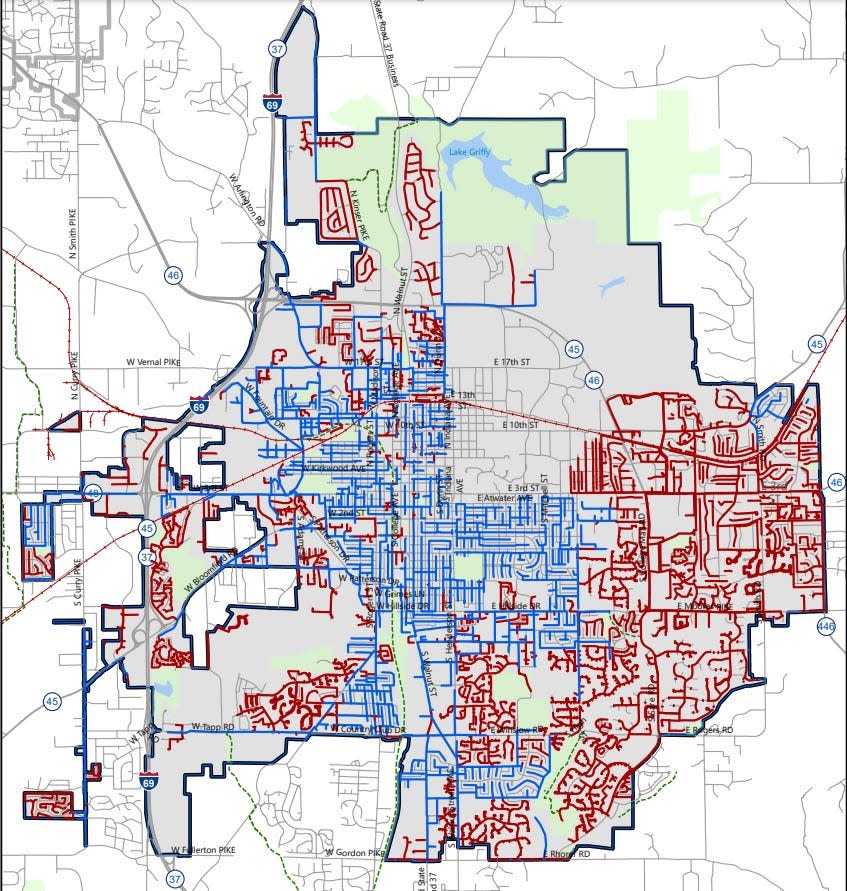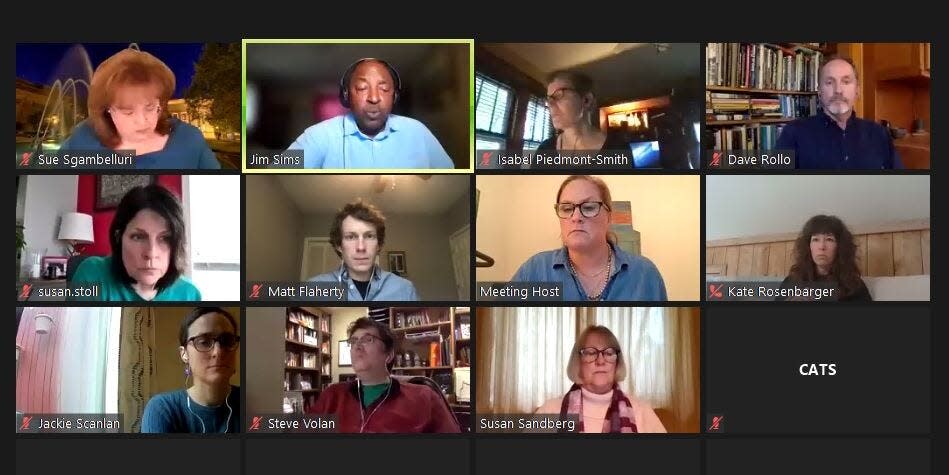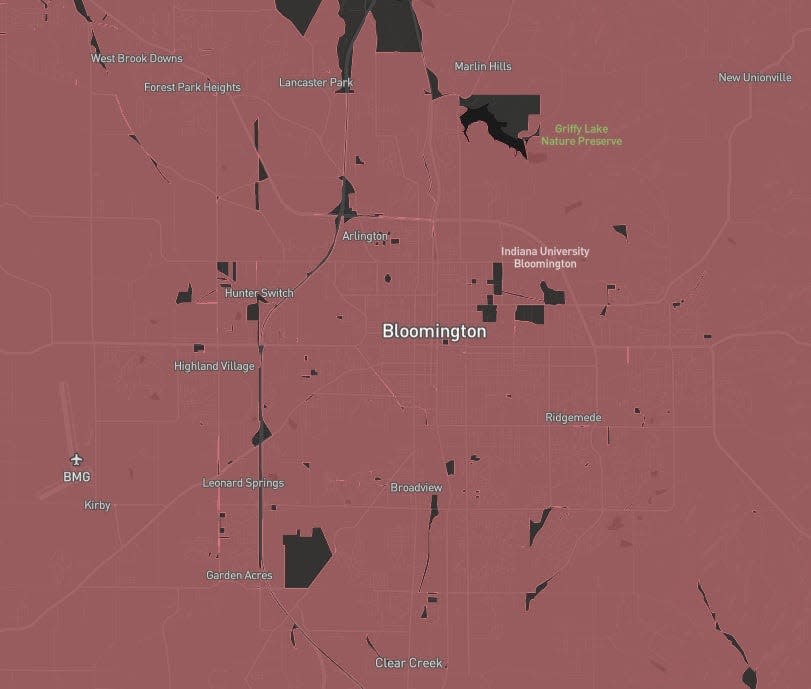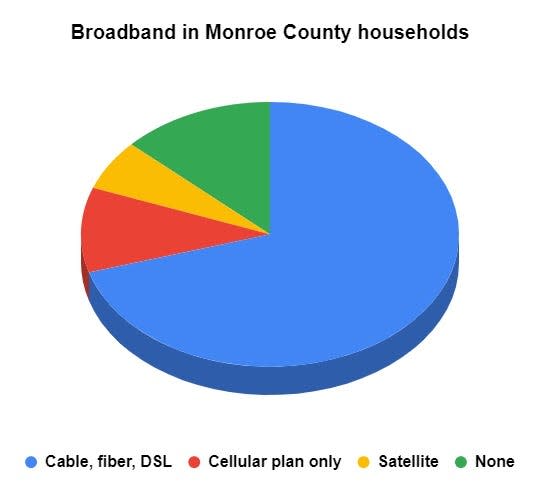Super fast internet service — from a mystery provider — coming as early as end of year
Bloomington residents, some as early as a few months from now, will get another option for broadband internet service, thanks in part to a $10 million tax break the city has agreed to provide to France-based infrastructure company Meridiam.
In return, Meridiam will invest $50 million in Bloomington to lay and hang fiber optic cables that within the next three years are required to reach at least 85% of the city’s population.
The administration of Mayor John Hamilton, which has worked on a deal like this for six years, envisions a future-proof internet service that provides Bloomington residents and businesses with blazing download and upload speeds at costs comparable to existing providers.
Still an issue: In Indiana, many still lack broadband access

Low-income earners would even get a fast — but not quite as fast — service for free.
The efforts of Bloomington leaders resemble those of other communities. In communities across Indiana, the U.S. and even outside of the country’s borders, leaders have said the pandemic demonstrated high speed internet service is nearly as important as other utilities — water, sewer, electric — in enabling people to partake in modern society, especially if they want to work and/or learn from home.
“We have a potential transformational investment before us for basic infrastructure for the 21st century, really like electricity was for the 20th,” Hamilton told the city council this month. “And we have a potential investment in front of us that is uniquely powerful as a tool for inclusion and … digital equity to improve opportunity literally to thousands of local households.”
The deal has received support from several local agencies, but needs one final vote from the redevelopment commission before contracts can be inked. That vote is scheduled for July 5.
Several unknowns remain
The city council this month approved the deal with Meridiam by an 8-1 vote, but a lot of questions about the service remain unanswered.

Neither Meridiam nor the city have disclosed the internet service provider that will get exclusive access to the infrastructure for five years. The parties said they cannot reveal the ISP until contract negotiations have concluded.
While speed — 250 megabits per second — and price — $0 after a federal subsidy — for low-income households are known, it is unclear what speeds, tiers, prices and connection fees the bulk of Bloomington residents will experience. Council member Dave Rollo rejected the deal in part because of the unanswered questions.
In addition, Meridiam has not completed such a project in the U.S., though it is in the development stages of a similar public-private partnership in Canada and has three similar projects in various stages in Europe.
Existing providers not happy
The city’s deal with Meridiam also has elicited criticism from incumbent internet service providers, whose cadre of spokespeople in recent weeks has descended repeatedly upon the city to cry foul in public meetings over the city’s tax break for a competitor — no less one that, the incumbents say, is not necessary based on current broadband coverage.
To the city’s information technology director, Rick Dietz, that charge arrives with about as much surprise as a Windows update 60 seconds before an important Zoom meeting.
“It is understandable that incumbent providers don’t want greater competition,” he said, wryly, at a recent city council meeting.

The local incumbents, Comcast, AT&T and Spectrum, even got support from the Washington, D.C.-based so-called Taxpayers Protection Alliance, which sent a representative from the nation’s capitol to warn city council members they would be using taxpayer resources “to build out redundant infrastructure.”
Sourcewatch classifies the alliance as “an advocacy front group” that is part of the Koch brothers’ political network. According to the Louisville Courier-Journal, a sister paper of The Herald-Times, the alliance in 2017 “led an online campaign, urging Louisville taxpayers to reject the city's plans to spend public money on the fiber network.”
Councils in both cities rejected the alliance’s arguments. Bloomington city council members said the deal merely requires the city to essentially refund to Meridiam $10 million in tax payments the company will be paying on the equipment it is installing. Without the tax break, the investment wouldn’t be made, in which case it wouldn’t generate tax dollars in the first place, they said.
Like city leaders elsewhere, Bloomington officials said they are tired of spotty and slow internet connections despite having asked incumbent providers for years to invest more in their local networks to improve the service and to extend it to low-income neighborhoods.
However, Mike Wilson, public relations director for Comcast Indiana, said while Meridiam plans to provide service to at least 85% of Bloomington’s population, Comcast is already providing broadband service to “virtually all of Bloomington.”

Except the university campus and some apartment complexes that have exclusive deals with a provider, everybody has access to 1.2 Gbps service from Comcast, Wilson said. And people with low incomes can use the federal credit of $30 toward the cost of the service.
“There isn’t an access issue in Bloomington,” he said.
Hicks: How to think about the infrastructure bill
Some data from the Federal Communications Commission supports his contention. A map from the U.S. government agency shows broad coverage in Bloomington from both Comcast and AT&T.
However, the FCC considers anything above a download speed of 25 Mbps to be broadband, and Dietz said that measure is simply no longer adequate for families using internet connections for an increasing number of applications including schooling, work, gaming, telehealth, home security, smart speakers, smart thermostats and smart TVs.
According to Consumer Reports, consumers need only a 25 Mbps connection to stream a movie in ultra high-definition resolution — but if two parents in a household want to watch different movies at the same time, they'll need 50 Mbps. And if one of the children wants to talk to grandma on Zoom at the same time and another child is scaling through the Twisting Corridors of Thorghast, they'll need even more bandwidth.
Any kind of video conferencing, for learning or work, for example, also requires significant upload speeds, which the FCC standard essentially disregards.
FCC maps show a third of Bloomington residents has either one or no option for download speeds of 100 Mbps coupled with upload speeds of 10 Mbps. For 250/25 service, two-thirds of residents have only one possible provider.

An unscientific survey showed half of of 26 Bloomington residents in various housing types had download speeds of less than 50 Mbps. However, it’s difficult to tell what’s causing the lower speeds, as they can be affected by the providers’ infrastructure and prices as well as the customer’s equipment and willingness to pay for better service. Some customers also simply may not have the bandwidth to research what services are available to them from whom, at what speeds and at what price.
According to the U.S. Census Bureau, 86.6% of Bloomington households have an internet connection, though only 71.2% have a connection via cable, fiber or DSL. Another 10.6% use their cell phones.
And 13.4% of households have no internet connection at all, with the share being highest for the households with the lowest incomes: Among households with earnings of at least $75,000, 4.7% had no internet connection. That share was 17.8% — or nearly 1 in 5 — for households making less than $75,000.
Wilson, of Comcast, said the company continues to invest all over the country — and millions in Indiana alone — and has begun to implement plans to make symmetrical “multi-gig speed” available everywhere.
“Technology has to keep moving … so we can keep up with future demands,” he said.
City leaders said they’ve heard such statements before, only to be left disappointed.
Dietz, the city’s IT director, has said in public meetings that the incumbents typically say they provide speeds of “up to” something, which can mean anything below that number, or that they’re “working towards” a goal — usually a stubbornly elusive one — or are “planning” to do something that rarely or never happens. He said that’s especially true in low-income neighborhoods where infrastructure investments are deemed cost prohibitive because not enough people sign up for the service to produce a return on the initial investment.
Dietz said the city wants some community control over the fiber network because it does not want to continue to be left to the “whims of the marketplace,” which haven’t served the city as well as city leaders had hoped.
“The current providers are not meeting our objectives and we believe that greater competition will help,” he said.
Leaders in other communities in Indiana and across the country agree and have made broadband available either through public-private partnership as proposed in Bloomington or by publicly funding an internet utility to provide broadband much like they provide water or sewer service.
For example, residents in Fort Collins, Colorado, voted in 2018 for the city to issue $150 million in bonds to enable the city's power utility to install broadband infrastructure.
Chad Crager, the city’s broadband executive director, said residents complained about slow speeds and spotty access.
The city initially considered a public-private partnership similar to the one being proposed for Bloomington, but abandoned that approach because Fort Collins leaders could not find the right partner.
For $60 a month, the city utility now provides customers with symmetrical 1 Gbps service, which, Crager said, “is huge.”
The city has the ability to provide 10 gig service to customers and has plans for 25 gigs “in the not so distant future,” he said.
The plans in Fort Collins had some initial detractors, including the local chamber of commerce.
Ann Hutchison, president and CEO of the Fort Collins Area Chamber of Commerce, said the chamber would have preferred a public-private partnership.
“We were anxious about (the) government moving into a business that they simply didn’t have any experience with,” she said.
Hutchison said that residents who have signed up for the service appear to be pleased with the speeds they’re getting, and chamber leaders hope the venture succeeds, in part because it wants to make sure that the city can pay back its bonds.
Crager said the city’s utility needs about 35% of the city’s customers to sign up for the service, and so far the city has captured 30% — though not all residents and businesses yet have access.
He said he expects the city to exceed that 30% threshold because of the superior service and customer support: Whenever people have problems with their connection now, they call a local city official — rather than tech support in Boulder, Boston or Bangalore.
Crager acknowledges that the project has come with some challenges.
The city’s broadband infrastructure is completely underground, which increases reliability, because buried cables are immune to frost and wind damage, but Crager said, “I can’t tell you how many sprinkler systems we hit.”
“It’s not for the faint of heart to stand up a utility,” he said. “But the reward and control we have is phenomenal.”
Rollo, the Bloomington council member, said the public option in Bloomington was not explored enough, though Dietz, the local IT director, said the option would have come with too great a risk for the city. In addition, he said the Indiana Legislature likely would have tried to intervene to stop city from offering a public internet option given the incumbents' lobbying prowess and the city's ongoing confrontations with the state over annexation.
And cautionary tales about public interference with the broadband market remain, even close to Bloomington: Google sent shockwaves through Louisville in early 2019 when it abandoned its plans to lay fiber in the city, where it planned to focus the rollout on economically depressed neighborhoods.
According to the Courier-Journal, Louisville Mayor Greg Fischer "and economic development advocates eagerly (had) embraced Google Fiber, touting it as a key part of a $5.4 million proposal to expand the city's ultra-fast internet access under a larger public-private partnership called KentuckyWired."
Bloomington leaders have tried to find the right partner to install a fiber network for about six years. Dietz said they’ve gotten close, but each time they abandoned the deal because the would-be partner’s priorities changed or it was acquired by a third party that wanted to go into a different direction.
Now, Dietz said, the city has found the right partner, in Meridiam.
More: Why Bloomington and Monroe County should swing for the fences now
Meridiam officials could not be reached despite repeated attempts via email and phone, though a consulting company responded to emailed questions.
“Meridiam has considerable expertise working with communities to fill critical infrastructure gaps and benefit local economies, which include education … equality of opportunity in previously underserved communities, job creation, and quality of life,” the email read. “We are working with other Indiana communities, including Columbus, Shelbyville, Martinsville and eventually Bartholomew County, to provide fiber-based high speed internet access to their residents.”
Meridiam’s website indicates the company is involved in more than 100 projects ranging from data centers and highways in Africa to biogas plants and highways in Europe. The site says the projects focus on “critical public services, sustainable mobility and innovative low carbon solutions.”
The site says that Meridiam’s projects in Canada include the Montreal University Hospital Research Center and a road in Alberta, while projects in the U.S. include modernizing the central heating and cooling plant at the University of Fresno, California; a road tunnel under the port of Miami; a courthouse in Long Beach, California; roads in California, Colorado, Texas and Virginia; and the acquisition of a biogas facility in Idaho.
Meridiam has tackled broadband infrastructure projects in Europe, including in Montabaur, near Frankfurt, Germany. Officials there could not be reached by deadline, but German news reports and the website of the Internet Service Provider, Vodafone, indicate connection fees for households are free for people who sign up early, but later can cost more than $4,000. Vodafone is offering three speeds. The slowest connection, of 100 Mbps, costs $47 per month, and the fastest, gig speed, costs $47 for 12 months, and then $84 per month.
Meridiam and Dietz could not say what the connection fees would be for residents in Bloomington, but Dietz said he expects them to be in line with what incumbents charge to connect to their service.
Correction: This post has been updated to change a paragraph that confused upload and download speeds.
Boris Ladwig is the city government reporter for The Herald-Times. Contact him at bladwig@heraldt.com.
This article originally appeared on The Herald-Times: Bloomington fiber internet deal with Meridiam to bring fast speeds

